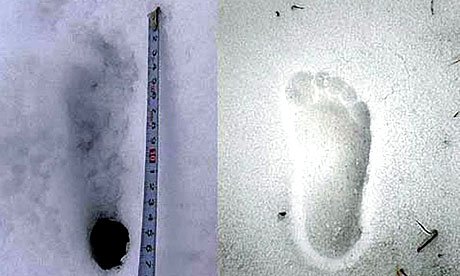Russian officials have said they have found “indisputable evidence” that yetis creatures exist and are living in Siberia.
The information has been heard during an international conference after an expedition tracked down Yeti in the Mount Shoria area.
But the expedition team has no convincing photographic or DNA evidence. Their claim appears to be based on bent branches, a single unclear footprint and a small sample of grey “hair”, found in a cave.
The cave is situated in the Kemerovo region, Russia, and local officials announced yesterday that “indisputable evidence” of Yeti existence had been found.
According to researchers who led the expedition, they are closer than ever to catching one Yeti.
“During the expedition to the Azasskaya cave, conference participants gathered indisputable proof that the Shoria mountains are inhabited by the Snow Man,” the Kemerovo region administration announced yesterday.
“They found his footprints, his supposed bed, and various markers with which the Yeti uses to denote his territory.”
But some Russian media reports have treated the Yeti claims with considerable skepticism.
Kemerovo officials said they are 95% certain of the existence of Yeti in a highland area known as Mount Shoria.
In the same time, the researchers themselves were less keen than the Kemerovo officials to claim the Yeti is definitely real. The specialists said that the hair sample should be analyzed for DNA – a process now in progress – before any claims were made.

The researchers have also found a bed of sticks and they claimed that the Yeti had slept on, but is not thought to have contained hair samples.
Dr. Igor Burtsev, leader of the international event – the first of its kind for half a century, claimed it would not be long before people everywhere would appreciate the Yeti’s existence.
“We are close to finally finding the Abominable Snowman,” Dr. Burtsev said.
Dr. Igor Burtsev claims around 30 Yetis live in the Kemerovo region, adding that they are Neandethal men who have survived to this day.
Since the fall of the Soviet Union 20 years ago, there have been increased “sightings” of Yeti, and it is claimed more than a dozen villagers and hunters in this vast mountainous region close to the town of Tashtagol have given written accounts of either seeing the beasts themselves or finding their tracks.
The villagers had also reported of the Yeti – claimed to be around 7ft-tall – stealing livestock from remote farms.
But none of the local eye-witnesses gave evidence directly to the session, though participants heard other accounts from around the globe.
“We were shown some twisted willow branches that are referred to as markers – they were convincing evidence of this hominoid,” said John Binderangel, a Canadian Yeti researcher, who has spent 30 years hunting for conclusive proof of the Yeti.
“There were also some tracks, but we’re not quite sure what to make of them.”
During the conference, an American housewife told audience she regularly feeds Yeti in her back garden in Michigan but was unable to produce a single photograph of an elusive creature rumored to exist for thousands of years.
After the specialists ended the expedition, another hunt to the same cave to find the Yeti was led by the “Beast of the East” – former Russian heavyweight boxing champion Nikolai Valuyev. Nikolai Valuyev’s expedition ended in failure, though locals saw it as a key plank in the region’s bid to boost tourism.
“Valuyev did not manage to meet the Yeti itself but on the way he discovered <<traces>> such as broken tree branches,” said a spokesman.
“I saw lots of journalists but no Yetis,” admitted Nikolai Valuyev.
Dmitry Islamov, Vice Governor of Kemerovo Region on Economics and Regional Development said:
“It doesn’t matter that the Kuzbass might not have Yetis. The main thing is that when people come to the Shoria Mountains, they truly enjoy its unique nature.”
The first accounts of Yetis emerged before the 19th century from Buddhists who believed that the creature inhabited the Himalayas.
They depicted the mysterious beast as having similarities to an ape and carrying a large stone as a weapon while making a whistling sound.
The term Abominable Snowman was developed in 1921 following a book by Lieutenant-Colonel Charles Howard-Bury called Mount Everest The Reconnaissance.
Popular interest in creature gathered pace in early 20th century as tourists began making their own trips to the region to try and capture the Yeti. The tourists reported seeing strange markings in the snow.
